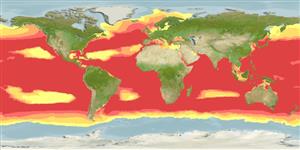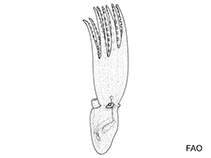Vitreledonella richardi Joubin, 1918
Glass octopod| Native range | All suitable habitat | Point map | Year 2050 |

|
| This map was computer-generated and has not yet been reviewed. |
| Vitreledonella richardi AquaMaps Data sources: GBIF OBIS |
Adicionar o seu Fotografias
Imagem do Google | No image available for this species;
drawing shows typical species in Vitreledonellidae.
Imagem do Google | No image available for this species;
drawing shows typical species in Vitreledonellidae.
Classification / Names Common names | Synonyms | CoL | ITIS | WoRMS
| Octopoda | Vitreledonellidae
Environment: milieu / climate zone / depth range / distribution range Ecologia
Batipelágico; intervalo de profundidade 0 - 1000 m (Ref. 96968). Subtropical
Distribuição Países | Áreas FAO | Ecossistemas | Ocorrências | Introduções
Worldwide except polar waters.
Length at first maturity / Tamanho / Peso / Idade
Maturity: Lm ? range ? - ? cm Max length : 45.0 cm TL macho/indeterminado; (Ref. 96968)
Found in mesobathypelagic waters of tropical and subtropical regions (Ref. 115077). Depth range from near the surface to at least 1,000 m, typically over deep water (beyond the continental shelf) (Ref. 96968). Thought to be found mostly near islands and sea mounts (Ref. 115077). Video sequences from submersibles suggest that the male envelops the female within his webs during mating. Females are thought to brood their eggs within their arm crown (Ref. 96968). Faint and less developed beak could be a sign of soft-bodied prey diet of early stages (Ref. 115077).
Life cycle and mating behavior Maturidade | Reprodução | Desova | Ovos | Fecundidade | Larvas
Members of the class Cephalopoda are gonochoric. Male and female adults usually die shortly after spawning and brooding, respectively. Mating behavior: Males perform various displays to attract potential females for copulation. During copulation, male grasp the female and inserts the hectocotylus into the female's mantle cavity where fertilization usually occurs. Life cycle: Embryos hatch into planktonic stage and live for some time before they grow larger and take up a benthic existence as adults.
Referência principal
Referências | Coordenador | Colaboradores
Turgeon, D.D., J.F. Quinn Jr., A.E. Bogan, E.V. Coan, F.G. Hochberg, W.G. Lyons, P.M. Mikkelsen, R.J. Neves, C.F.E. Roper, G. Rosenberg, B. Roth, A. Scheltema, F.G. Thompson, M. Vecchione and J.D. Willams. 1998. (Ref. 1667)
Categoria na Lista Vermelha da IUCN (Ref. 130435)
Preocupação menor (LC) ; Date assessed: 20 August 2014
Categoria CITES (Ref. 108899)
Not Evaluated
CMS (Ref. 116361)
Not Evaluated
Ameaça para o homem
Utilização humana
| FishSource |
Ferramentas
Mais informação
Fontes da internet
BHL | BOLD Systems | CISTI | DiscoverLife | FAO(Publication : search) | Fishipedia | GenBank (genoma, nucleotídeo) | GloBI | Gomexsi | Google Books | Google Scholar | Google | PubMed | Árvore da vida | Wikipedia (ir para, procurar) | Registo zoológico
Estimates based on models
Preferred temperature
(Ref. 115969): 6.1 - 20.4, mean 12.2 (based on 1932 cells).
Categoria de preço
(Ref. 80766):
Unknown.



